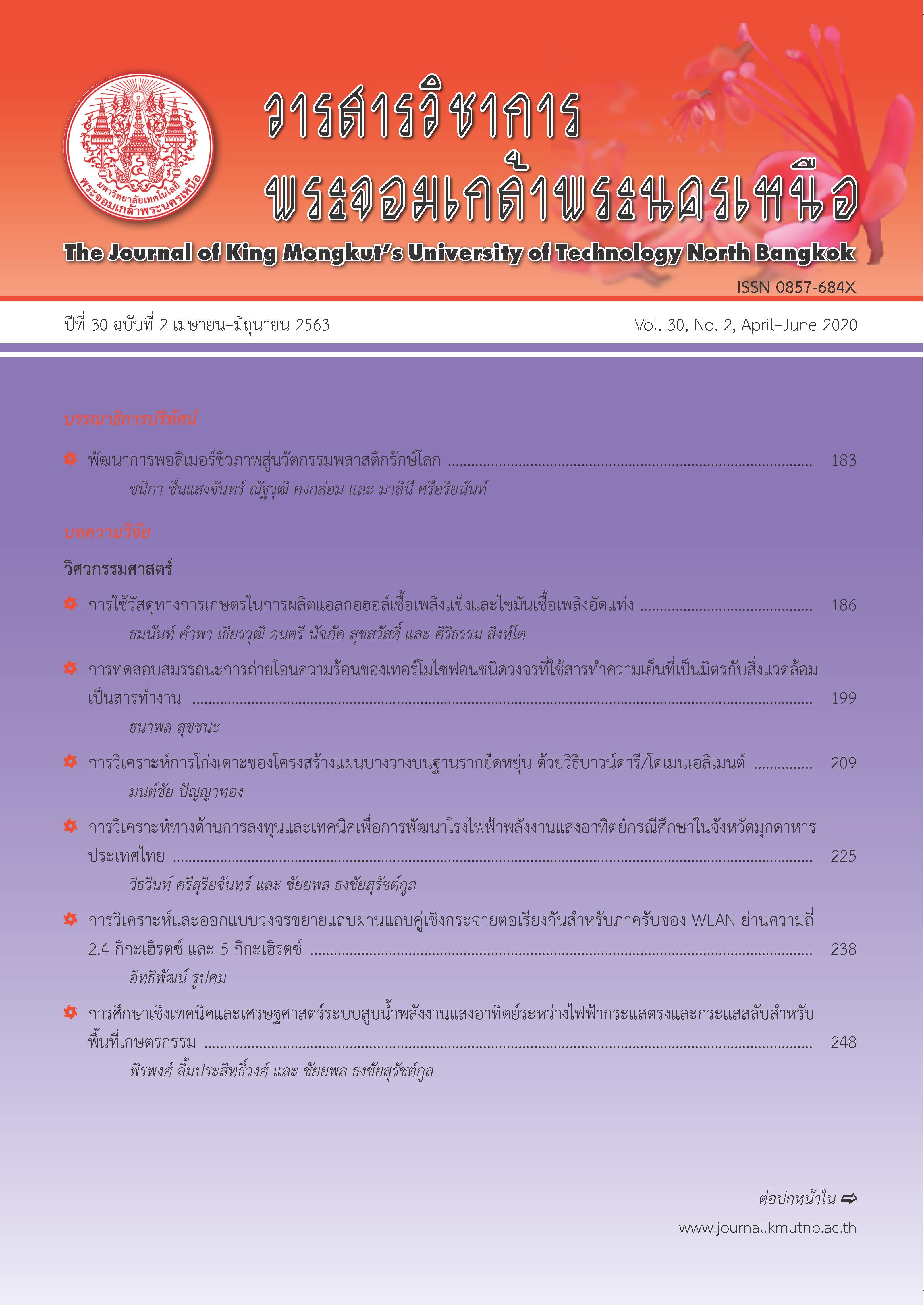The Utilization of Agricultural Residues for Solid Fuel Alcohol and Lipid Fuel Briquette Production
Main Article Content
Abstract
This research showed the feasibility of using material residues from household and industry for remanufactured products. Solid fuel alcohol and lipid fuel briquette prepared with agricultural residues (rice husk, coconut coir dust and chopped mango branches) were produced and their fuel properties were tested. The result showed that the agricultural residues with chopped mango branches and rice husk had high heating values of 4,020 and 3,330 kilocalories per kilogram, respectively. The values of these residues indicated good properties particularly for the fuel supply purpose. In comparison, the solid alcohol, without adding any residue and with adding the chopped mango branches, showed high heating value of 4,820 and 5,030 kilocalories per kilogram, respectively. After the 1-month storage of the solid alcohol fuel, the fuel with chopped mango branches show no statistically significant difference in period of rolling boiled temperature (291 seconds), compared with the one obtained from the solid alcohol on the date of production (233 seconds). Adding agricultural residues reduced loss of the net weight of the solid alcohol. However, adding the chopped mango branches showed increasing percentage of ash after storage for 2 and 3 months. This might affect to the fuel property of the solid alcohol. For production of lipid fuel briquette, the result showed that lipid without agricultural residue (control) had the highest heating value (8,210 kilocalories per kilogram). The lipid mixed with rice husk performed thermal property very well with the minimum boiling time (303 seconds) and the greatest rolling boil time (504 seconds) compared to the counterpart mixed with coconut coir dust and chopped mango branches. Thus, different agricultural residues could affect to the fuel and thermal properties of both solid fuel alcohol and solid lipid fuel briquette.
Article Details
The articles published are the opinion of the author only. The author is responsible for any legal consequences. That may arise from that article.
References
[2] S. Choojun, Organic Acid Production from Biomass Residue. Bangkok: Chulalongkorn University Press, 2011, pp. 4–15 (in Thai).
[3] H. Du, J. Fan, and W. Wu, “Rapid preparation of solid alcohol,” Advance Materials Research, vol. 781–784, pp. 131–134, 2013.
[4] Thai Industrial Standards Institute. Thai Industrial Standard for Solid Fuel Alcohol 950-2547. Ministry of Industry. Bangkok, Thailand [Online]. Available: https://www.tisi.go.th/data/standard/fulltext/TIS-950-2547m.pdf
[5] S. Kulwatanaporn, “Production of solid alcohol,” Science and Technology Journal, vol. 15, no. 3, pp. 75–77, 2000.
[6] D. W. Knight and I. R. Morgan, “Alcoholcontaining compositions useful as solid fuels and processes for their manufacture,” Patent no. US20150111972A1, 2012.
[7] G. Pristouri, A. Badeka, and M. Kontominas, “Effect of packaging material headspace, oxygen and light transmission, temperature and storage time on quality characteristics of extra virgin olive oil,” Food Control, vol. 21, no. 4, pp. 412–418, 2010.
[8] D. Sirivilai, C. Poboon, and W. Phoochinda, “Wastewater management of local authorities: A case study of Muangklang Municipality, Rayong Province,” NIDA Journal of Environmental Management, vol. 8, no. 2, pp. 1–19, 2012 (in Thai).
[9] S. Mungmeesith, “Construction of biomass furnace for local community,” Silpakorn University Journal, vol. 1199, no. 40, pp. 1–50, 2011 (in Thai).
[10] Expert Center of Innovative Herbal Products, “Extract from black Ginger and Tamarind seed,” Thailand Institute of Scientific and Technological Research, PathumThani, Thailand, 2017 (in Thai).
[11] S. Kanokpanont, S. Inthaphunt, and A. Bunsiri, “Synthesis of carboxymethyl cellulose from young coconut husk,” Songklanakarin Journal of Plant Science, vol. 4, no. 4, pp.60–65, 2017 (in Thai).
[12] K. Chaiwong, N. Wichan, A. Santawee, J. Tawornngamyingsakul, and T. Junhom, “Effect of inlet air flow on thermal efficiency of Bio-char stove on agricultural waste” RMUTL Engineering Journal, vol. 1, no. 1, pp. 37–42, 2016.
[13] N. Namkam, “Efficiency evaluation on biomass furnace combustion chamber of refractory insulator,” Science and Technology of Nakorn Sawan Rajabhat University Journal, vol. 9, no. 9, pp. 37–49, 2017 (in Thai).
[14] N. Tangmunkongworakul, “The production of fuel briquettes from bio-agricultural wastes and household wastes,” Srinakharinwirot University Journal of Science and Technology, vol. 6, no. 11, pp. 66–77, 2014 (in Thai).
[15] L. Wattanachira, N. Laapan, V. Chatchavarn, A. Thanyacharoen, and P. Rakruam, “Development of biobriquettes from mixed rice-strawand longan waste residues,” KMUTT Research and Development Journal, vol. 39, no. 2, pp. 239–255, 2016 (in Thai).
[16] K. Wanchai and P. Prangbang, “Biodiesel production from palm oil using KI/CaO/Al2O3 as a solid base catalyst,” Thai Science and Technology Journal, vol. 23, no. 5, pp. 774–782, 2015 (in Thai).
[17] S. Chirachakhrit. (2009, January). Biodiesel production from use vegetable oil. Engineering Journal Siam University [Online]. 18(1), pp. 1–8. Available: http://ejsu.siam.edu/journals/PDF_18/5.pdf

